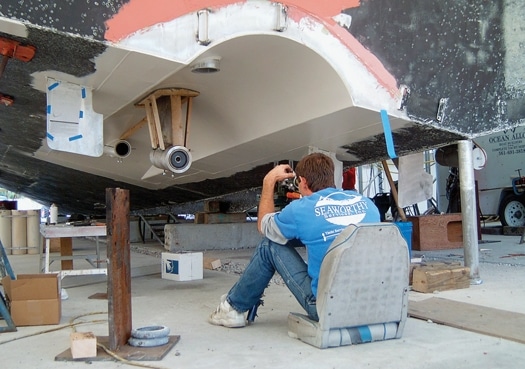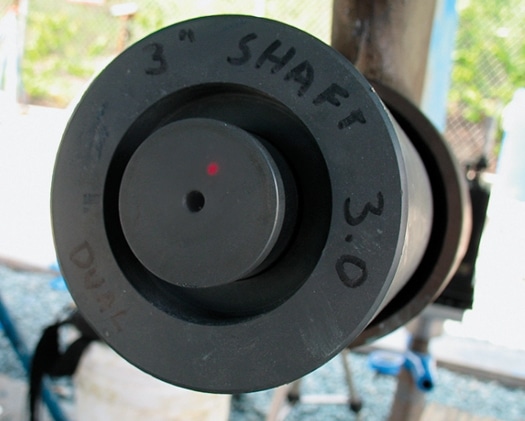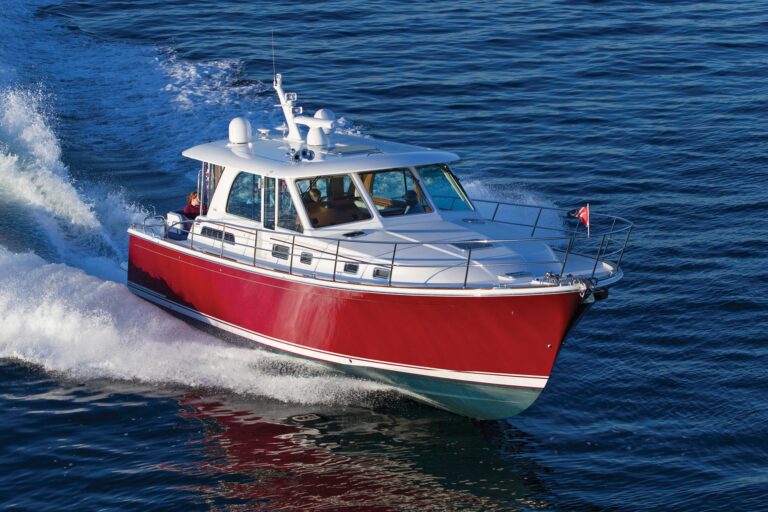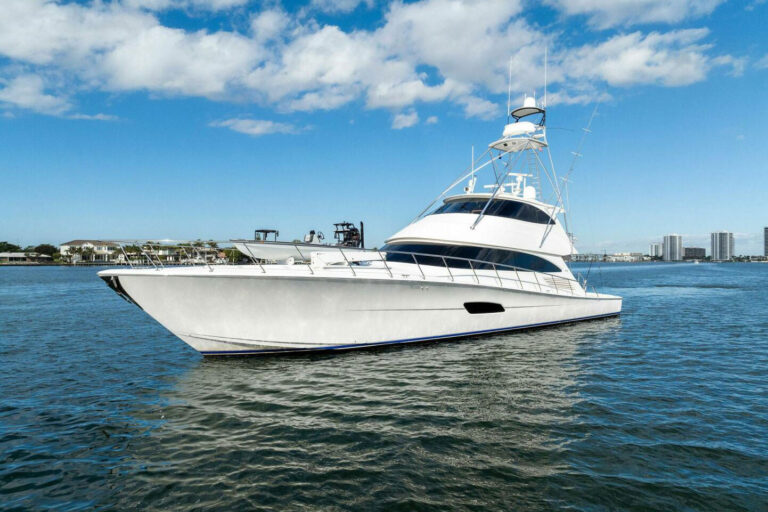
ytgsep15yy525.jpg
Advances in hulls, engines, propellers, and even acoustic materials have all made boats stronger, faster, and quieter. Today we’ve come to expect luxury-car comfort aboard 100,000-pound yachts traveling 30 knots. But the shafts, struts, and bearings that tie engines to props have changed little since the mid-1800s when the screw propeller eclipsed the paddle wheel, and quirks in this drive train often cause vibrations. Fortunately, a few specialists are employing sophisticated methods to find and eliminate vibrations from shaft and strut technology that far predate the Model T.
“Everyone wants their boat to run like a Lexus. They don’t want to feel a thing,” says Fred Zucker, president of Seaworthy Services in Palm Beach Gardens, Florida(www.oceanalloys.com). “Unfortunately, the human body is particularly sensitive to the frequencies of vibrations typically found on yachts.” Zucker has been building yachts and chasing vibrations for over 35 years, back when a mechanic’s experience, intuition, and the soles of his feet helped track down annoying, repetitive thumps.
“We learned from trial and error what makes a boat shake,” Zucker says. “We’d take boats apart, fix something, put them back together, and go on a sea trial, but often we’d still get fooled.” Today Zucker relies on years of acquired knowledge, but uses sensitive accelerometers connected to computers to analyze the sources of onboard vibrations. “When something is thumping, we want to know how many times a minute-the vibration’s frequency-and how hard-its amplitude,” Zucker says. By determining the frequency, Zucker can match it to the offending equipment. A bent propeller, for instance, will vibrate at some multiple of shaft speed, depending on how many blades are damaged, whereas a bent propeller shaft taper is subtly different.
“You’ll see an abnormal propeller signature,” Zucker says, “But you’ll also get a thumping vibration at the frequency that the propeller shaft is turning.” Problems originating from an engine itself will usually show up at one half of engine rpm since, on four-stroke diesels, each cylinder fires on every other rotation of the engine. Misfiring generators, too, will vibrate at half their rpm, and other pumps and equipment can be tracked down similarly.
Zucker warns, though, that while measuring vibrations is an exact science, interpreting the results is still largely an art. “This is complex machinery moving in a dynamic environment,” he says. “You’ve got to understand the construction of the boat you’re working on as you’re taking these readings.”
Zucker says one common misdiagnosis is mistaking an exhaust issue-producing a vibration frequency that is some multiple of the number of cylinders times engine rpm-for a propeller problem-which vibrates at the rate the shaft is turning times the number of propeller blades. The close frequencies often compound either issue. “A vibration may start out as an exhaust problem at lower speeds and then become a propeller problem at higher speeds. Somewhere in between, if those two frequencies overlap, they may cause a much larger vibration than either the exhaust or the propeller would independently.”
Finding the cause, or causes, of vibrations is only half the battle. While many specialists employ equipment and techniques similar to Zucker’s, Seaworthy Services actually does the work necessary to mitigate the shakes. “There are some very smart people doing [vibration analysis],” Zucker says. “But we sea trial the boats and see the computer diagnosis, and then we take the nuts and bolts apart and actually see the problem, and either prove or disprove what the computer is saying.” Zucker enjoys the instant gratification, and he also learns nuances from each repair that aid him in future, tricky diagnoses.
As mentioned, misaligned propeller shaft bearings are responsible for many vibration issues. Zucker says about half of the boats he works on for vibration mitigation have at least one misaligned or misplaced strut or shaft log. The shaft log is the tube that allows the shaft to penetrate the hull, with the stuffing box or shaft seal at one end, and typically a bronze and rubber shaft bearing within. Fortunately, resolving these alignment issues has gone high-tech, too.
“The first step, and the key to getting it right, is to make sure the yard blocks the boat just like it sits in the water,” Zucker says. The age-old method relied on strings or wires suspended tightly across the boat, with measurements taken from these wires to key points. Today technicians use laser equipment developed for land surveying, which shoots beams of light at precisionadjustable horizontal and vertical angles. “We use multiple laser systems and set up numerous targets before the boat is hauled,” Zucker says. “Then we make sure we hit those targets again as the boat is blocked.” The goal is to prevent misshaping or twisting the hull by supporting it exactly as the water does. Engines, too, are targeted, so they remain in the precise position they’ll take when the boat is relaunched.

| | |
With the boat sitting on land just as it floats, and with the propeller shaft removed, Zucker shoots a laser from the propeller’s normal position, up through each strut and the shaft log, off a mirror placed on the transmission’s shaft coupling that bounces it back toward the propeller. “Each laser is set up on four-plane micrometers,” Zucker says. “We can adjust them up and down, side to side, or tilt them, measurable in thousandths of an inch.” Inserts in each strut ensure the laser finds both the strut’s center and angular alignment to within thousandths of an inch, and a target on the forward-facing surface of the insert indicates how far off center the reflected laser beam is. “When that laser beam shoots up to a mirror on the transmission’s coupling and straight back into itself, we know we’re dead-on,” Zucker says.
Rather than moving each strut, Zucker looks for at least two points that are aligned within tolerances, and moves other components to match, reducing the job cost. Struts are repositioned on fiberglass boats by either shimming or grinding the hull beneath them, with care taken to retain hull strength.
As the shaft bearings are aligned, the engine is also brought into precise alignment with the shaft. “Even experienced yacht people think that if you get the two faces of the propeller shaft coupling exactly parallel, the engine is aligned, but you’ve got a huge amount of weight, seven or eight feet of shaft and a heavy coupling, hanging out there unsupported once it leaves that last bearing,” Zucker warns. “All too frequently we find that the front end of the engine is about a quarter- to a half-inch low. The back is a bit low, too, because the engine had been aligned to a drooping shaft.” Zucker’s technicians prevent this with the same laser system, raising or lowering each of the four corners of an engine until the transmission’s output shaft is exactly parallel to and centered with the propeller shaft. A laser reflected off the coupling verifies the angle, and shooting it into a precisely centered target ensures vertical and horizontal alignment.
Zucker has further streamlined his system with high-resolution cameras viewing the laser targets and broadcasting to monitors in the engineroom and at the laser. “Rather than having one guy outside the boat telling someone inside the boat which way to move the engine, one or two guys working entirely within the engineroom can align an engine very quickly,” Zucker says. “When we slide the shaft up, we check that the coupling surfaces are parallel with a feeler gauge, but we’re usually within one or two thousandths. You can’t machine a shaft and coupling with the kind of accuracy we’re getting.”
Even with everything precisely aligned, some boats still vibrate. “Sometimes struts themselves will move. It’s a resonant frequency response to the shaft spinning through the strut. If you go a little faster or a little slower, it usually goes away, but a minor nick in a propeller blade may excite that strut and cause a noticeable vibration,” Zucker explains. “Like a tuning fork, there will be some frequency that every single-leg strut will vibrate at. Hopefully it is not at cruise rpm.” To avoid this, yacht designers try to design struts with resonant frequencies outside the normal range of propeller shaft rpms, though they’re not always successful.
Zucker and other vibration experts tell of innumerable variations and dozens of oddball circumstances that cause hard-to-find vibrations. In the past, yacht owners often just accepted them as too expensive or troublesome to find. But thanks to technology, today every boat can ride like a Lexus.
| Get In Line ******Here are some additional resources for information on shaft alignment.** ******Sea Worthy Services** Palm Beach Gardens, FL oceanalloys.com Maritech Acton, MA info@maritech-llc.com Reliability Maintenance Services Asbury Park, NJ (732) 922-8878 |








